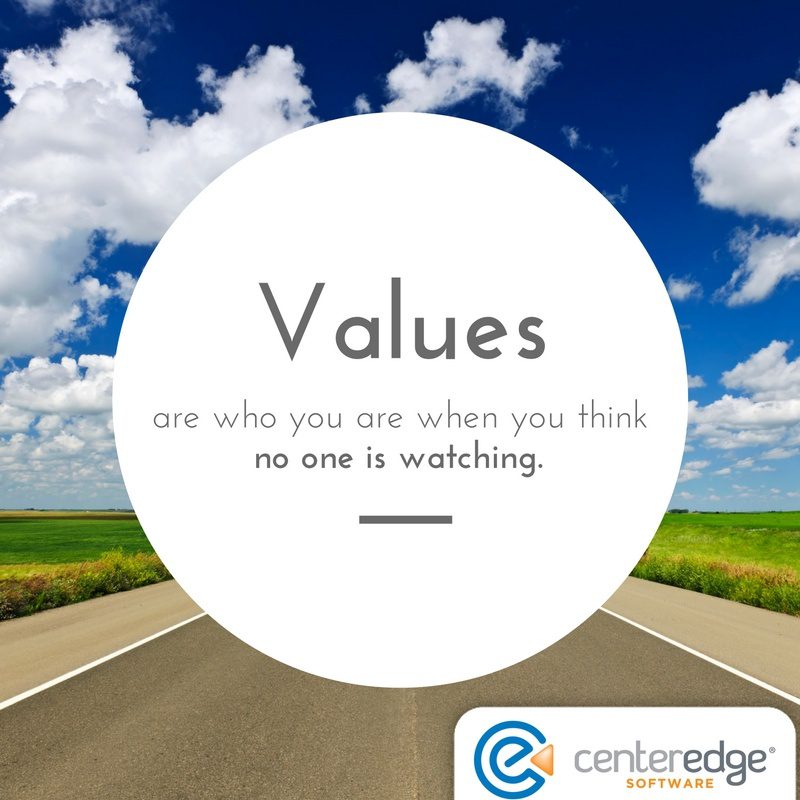Over the past six months, we have been working on strengthening our culture and teamwork at CenterEdge. We began this journey by examining our current culture, celebrating where we have been winning, and putting thought around where we need to improve. It’s been going terrific! We have completed several training initiatives for our entire team, including both technical training as well as soft skills training. And we’ve spent more time listening to our team members.
Listening to our team has, in my opinion, been the best step we’ve taken. Who better to tell us where we need focus than the people living it day to day? We’ve asked them questions about what areas they need additional training in, how CenterEdge can improve their work lives, what more we can and should be doing for the people we serve, and what types of things motivate (and demotivate) them. The result has been the rolling out of a new platform for the team to recognize each other, new service anniversary recognition, client feedback drawings and a few more surprises they don’t even know about yet.
Perhaps the most important tangible result from this culture initiative has been the redefining of our core values. Core values can be a bit of a buzz phrase, but the one thing I have learned is that every company has them (good and bad). I saw a great quote that read, “values are who you are when you think no one is watching.” So the first thing that needed to be done was to see who we really are. Here are the steps that we took to discover who we are and who we want to be as a company:
- We held a focus group. Team members (not managers) from every department volunteered to meet and answer questions about values. Among them, we asked, “based on what you see, do and hear every day at work, what do you think we value as a company – positive or negative? The key was to create a safe environment for them to feel like their voice was heard. Patrick Lencioni’s book, “The Five Dysfunctions of a Team” talks about trust being the very first level. The team needs to be able to trust each other in order to be honest with the company’s shortcomings. As it was explained in our meeting, “we can’t improve if we don’t know what needs improvement.”
- From there we prioritized the 3-5 most important ideas to us as a company. We ranked them individually and then averaged the results. We had some clear winners and some that needed more discussion to understand the real value.
- After the group meeting, I took the entire list of values that we had developed and asked the management team to prioritize their top 5. Afterwards, I shared the focus group’s top values and the two lists were quite similar! This told us that we have been moving towards being aligned with these values for some time, and that the people being hired today hold similar values to the company’s, which is the only way a company’s values can truly be livable, and thereby believable.
- Next came defining each of the values. The reason why the term core values causes some eye rolls is because people think that they are merely words on the wall or the web site. Simon Sinek describes values as not being ideas at all, rather they should be actions. We wanted to share our ideas, our belief system outwardly, but also drill down the actions into our own words. So the results are the ideas and the actions that express who we are. CLICK HERE to check them out. We are so proud of the values that we created together, and have begun to see a real shift in, not only how we treat each other and clients, but also how we feel about the work we get to do as a team. But this was only the first part! Be on the lookout for Part 2 of this article to learn how we rolled out core values and culture training with our team, and how you can, too.
We’d love to hear how you’ve addressed or plan to address values with your teams! Reply or share it with us on social media, and send any feedback or questions to showell@centeredgesoftware.com.
Search Resources
Subscribe to Email Updates
Featured Resources
News //
CenterEdge Chosen as Exclusive Software Partner for Launch Entertainment Growth Plan

Blogs //
How to Build Better Relationships With Your Guests

Blogs //
7 Steps to an Improved Guest Experience

Blogs //
5 Features of CenterEdge’s New Integration with Semnox

Posts by Topic
- Advantage Payments (7)
- Brand Management (19)
- Business Growth (81)
- Capacity Management (2)
- CenterEdge News (30)
- Client Interviews (9)
- Credit Card Processing (3)
- Data & Reporting (12)
- Digital Signage (1)
- Event Management (20)
- Facility Management (10)
- Food & Beverage (8)
- Guest Experience (34)
- Guest Management (20)
- Holiday Season & Promotions (5)
- Industry Events (12)
- Inventory Management (1)
- Loyalty Programs (8)
- Marketing Tips (24)
- Operations (1)
- Point of Sale (10)
- Product Launch (11)
- Productivity (5)
- Profitability (35)
- Redemption Management (1)
- Sales (35)
- Season Passes (1)
- Team Training (60)
- Waivers (2)

Leave a Comment